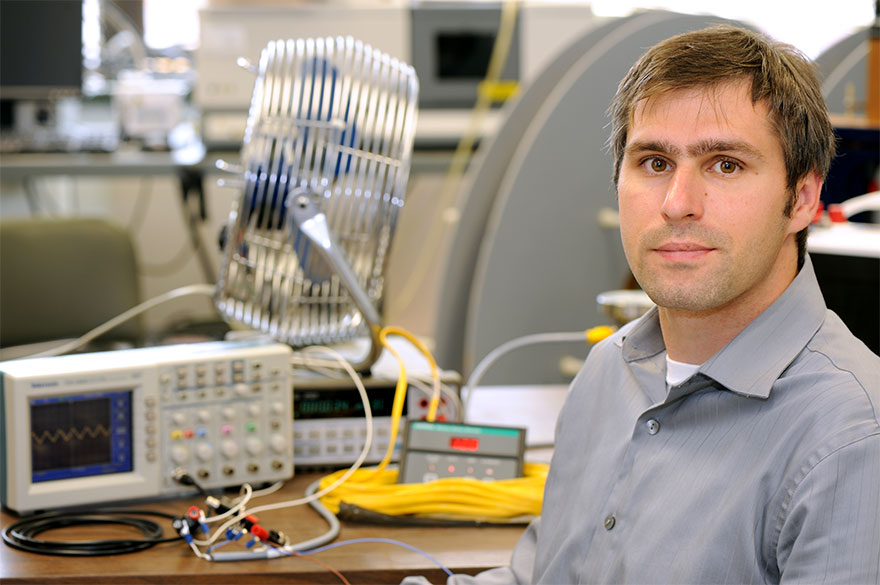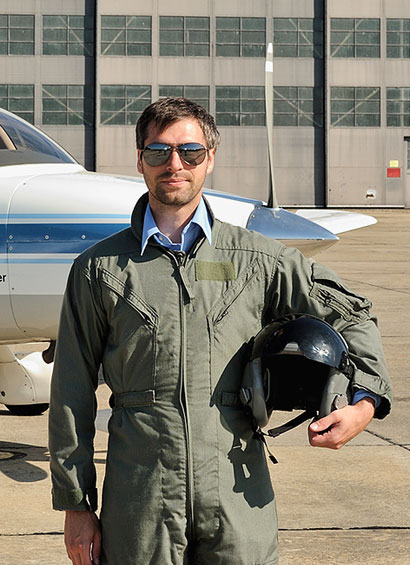



The lab at Naval Surface Warfare Center in Crane, Indiana, stands out as one of Indiana’s largest high-tech employers with more than 3,800 staff of which 2,500 are scientists, engineers, and technicians.
Interns, therefore, have a wide range of accessible talent and the opportunity to participate in cutting edge research and innovation under the guidance of passionate mentors who are in the top of their fields.
One of those mentors, Dr. Corey Bergsrud, himself an alum of the Naval Research Enterprise Internship Program (NREIP), takes particular joy in working with interns who, he says, bring in new ideas and inject fresh creativity into the R&D process at NSWC Crane. Bergsrud holds a PhD in engineering and is actively engaged in research at NSWC Crane, often serving as a project mentor where he works with many of the interns that work at the lab.
“It’s a role I like a lot,” he says. “I enjoy ideating with diverse teams, coming up with concepts that we turn into proposals and then seeing them through to creation. We all come to own that idea and share in the results.”
Bergsrud grew up in rural North Dakota. His father worked as an electrician and his mother as a secretary. At the University of North Dakota (UND), he discovered math – “I was somewhat good at it,” he says modestly – so he majored in math and electric engineering. This led to a master’s degree and then his PhD, all at UND.
Along the way, he interned at NASA’s Langley Research Center and was awarded the Department of Defense’s Science, Mathematics, and Research for Transformation (SMART) Scholarship-for-Service Program. He also interned twice at NIWC Pacific through the NREIP program. These experiences exposed him to defense research which he came to see as the right career move even among the many options that were available for someone with his skill set.
“They were the folks that were investing in me and seemed to like the work I was doing on electromagnets so that’s the path I took,” he recounts now.
Soon after finishing his doctoral studies, Bergsrud was offered – and accepted – a permanent full-time role at NSWC Crane where, among other duties, he manages interns.
The benefits of interning as a NREIP and SEAP at Crane are obvious to Bergsrud: “My lab is one that accepts flexible and creative innovation to explore ideas to mature and allows interns to hone in on their own technical capabilities.” Bergsrud, in fact, believes that places like NSWC Crane have the most to offer when it comes to opportunities to try out new ideas. “Defense is one of the few places where you can be truly creative. Through our defense innovation ecosystem and the partnership ecosystem, you get to see a lot of things you wouldn’t otherwise.”
As an example of projects that allow for – and even require – creativity, Bergsrud points to their “origami robotics” project, origami-inspired machines that can transform themselves while in the field to adapt their shape depending on the specific environment or task on hand, optimizing their use for additional missions. Two interns – Amelia and Gabe – have been working with Bergsrud and other scientists at NSWC Crane becoming leads on the project, applying their own ingenuity to what could be described as life-size puzzle.
Amelia, who started with the lab as a Science and Engineering Apprenticeship Program (SEAP) was later accepted into the STEM Student Employment Program (SSEP) and will soon be working on her capstone project incorporating what she learned at NSWC Crane. Gabe is an SSEP intern and is now studying for a masters in robotics at the University of Pennsylvania.
The benefits of the programs to NSWC Crane are even more substantial in Bergsrud’s mind. There is, of course, the injection of new ideas interns bring but the interns also serve as a bridge to future partnerships with their universities, professors, or the companies they go work with. Interns cross-pollinate between the labs and the departments they return to, and many interns go on to careers in academia or in private research, making them obvious future collaborators.
It's these kinds of alliances that really motivate Bergsrud and he talks as though he’s on a mission to build on their successes.
“In defense, we’re still new to understanding how a lot of this works,” he says about adopting a startup culture or ecosystem mentality. “If we want to be successful outside, we need to strengthen our network and adopt new innovative practices. Through partnerships with interns, academia, other government labs, and even startup companies, we can get novel and emerging solutions to the warfighter much faster” through these partnership ecosystems by sharing resources.
Bergsrud says this also applies to innovation in technology outside of weaponry.
“There’s a lot of area in the ‘gray zone’ which is focused on diplomatic, information, and economic pursuits as well as military below the threshold of war. Engaging in dual applications helps us sustain these ideas longer and the results may have a more massive market than just high-priced defense products. By doing that, we can build up a larger market capacity to sustain these technologies for us and partner nations, maintaining our superiority for the duration.”